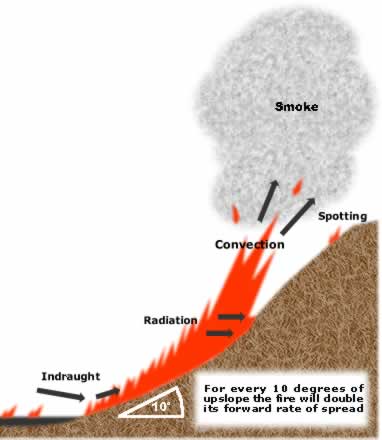Topography
The experimental burn plots at the Territory Wildlife Park are relatively flat so there is little topographic effect on the fires. However, in other areas topographic features can play an important role in influencing fire behaviour.
These topographic factors include slope steepness, aspect, elevation and configuration of the land. Variations in these can cause dramatic changes in fire behaviour.
Activity: Topography & fire behaviour
How does topography influence fire behaviour?
Pyne et al. (1996) provide a brief summary of how topographic features influence fire behaviour.
Reading:
Pyne, S.J., Andrews, P.L. & Laven, R.D. (1996) Introduction to Wildland Fire, p.50. Wiley, New York.
Fire moves more quickly upslope than downhill. This is because the flames are closer to fuels on the uphill side, which pre-heats them. In addition hot convective air from the fire moves upslope drying out fuels. As a rough rule, each 10% increase in slope, doubles the rate of fire spread. The reverse is the case down-slope.

Fire moving quickly upslope
On down-slopes or the lee-side of hills, fire spread can be more unpredictable due to wind turbulence. Gullies, narrow valleys and ridges can change wind speed and direction. Fire behaviour can be more erratic in complex terrain.
Activity: Extreme fire weather conditions
What conditions precipitated some of Australia's most tragic bushfires?
To recap this section, you will now read about some extreme fires and the weather conditions and landscapes associated with them. In 1939 Black Friday fires destroyed bushland and settlements in Victoria, and in 1983 Ash Wednesday fires swept across Victoria and South Australia. A number of people lost their lives in both tragedies.
More recently, in 2009 Victoria was devastated by the worst Bushfires in Australian history, in the Black Saturday fires. 173 people lost their lives, 2000 properties were destroyed, and over 430, 000 hectare of land were burnt. These fires are now the subject of the 2009 Victorian Bushfires Royal Commission.
The web resources indicated below provide descriptions of all aspects of the fires and their significance. Concentrate on the descriptions of fire weather provided, the topographic setting and the total area burnt.
While viewing the sites note any common weather conditions.
Resources:
The Bushfires History website details major bushfires in Victoria’s history, including the Black Saturday fire (2009), Ash Wednesday fires (1983), and Black Friday fires (1939).
The Bureau of Meteorology - Australian climate extremes - Fire website also gives more detail of these fire events specifically from a fire-weather perspective.
Reading:
Fawcett, R. J. B, Thurston, W., Kepert, J., and Tory, K. 2013. Modelling the fire weather of Black Saturday. In: R.P., Thorton and L. P., Wright (Eds) Proceedings of Bushfires CRC and AFAC 2012 Conference Research Forum. 28 August 2012, Perth, Australia, Bushfires CRC.